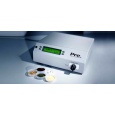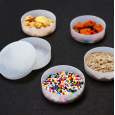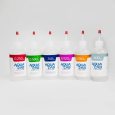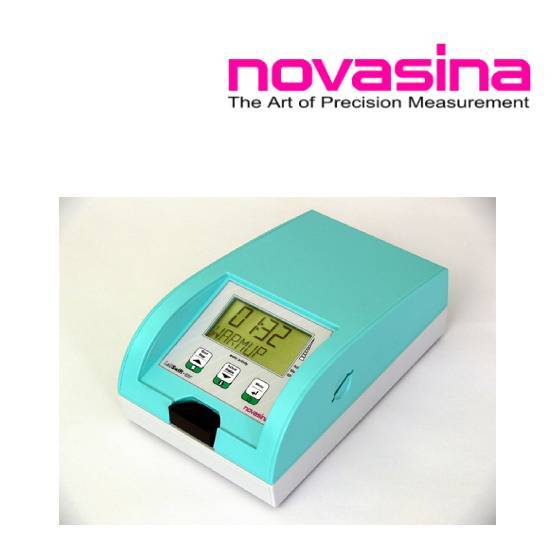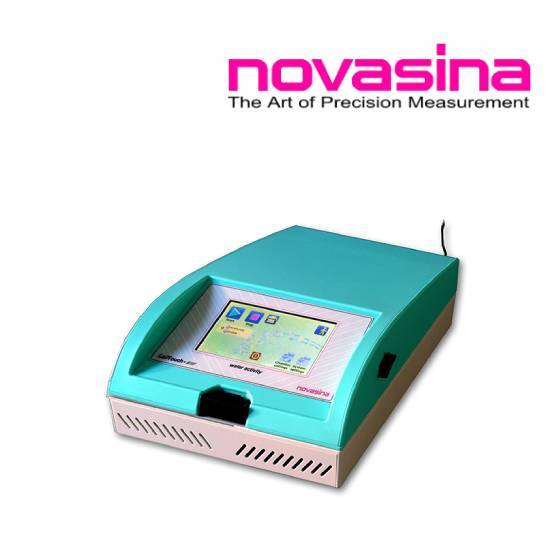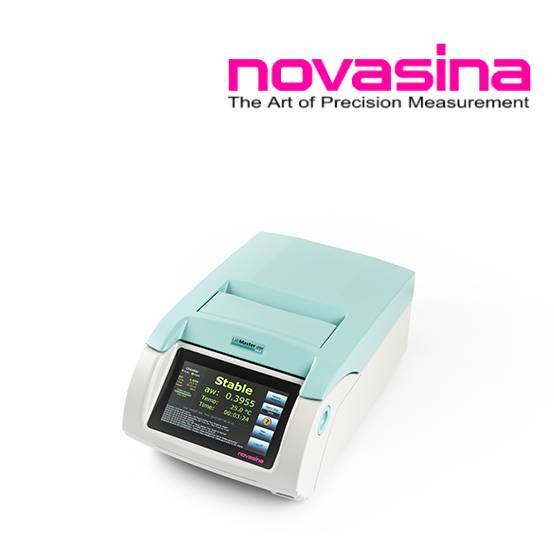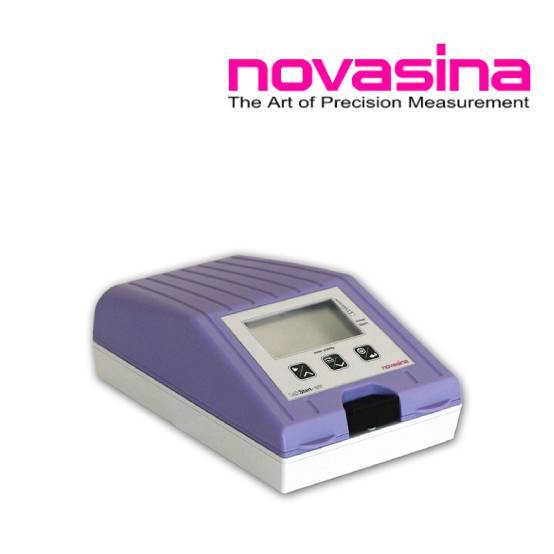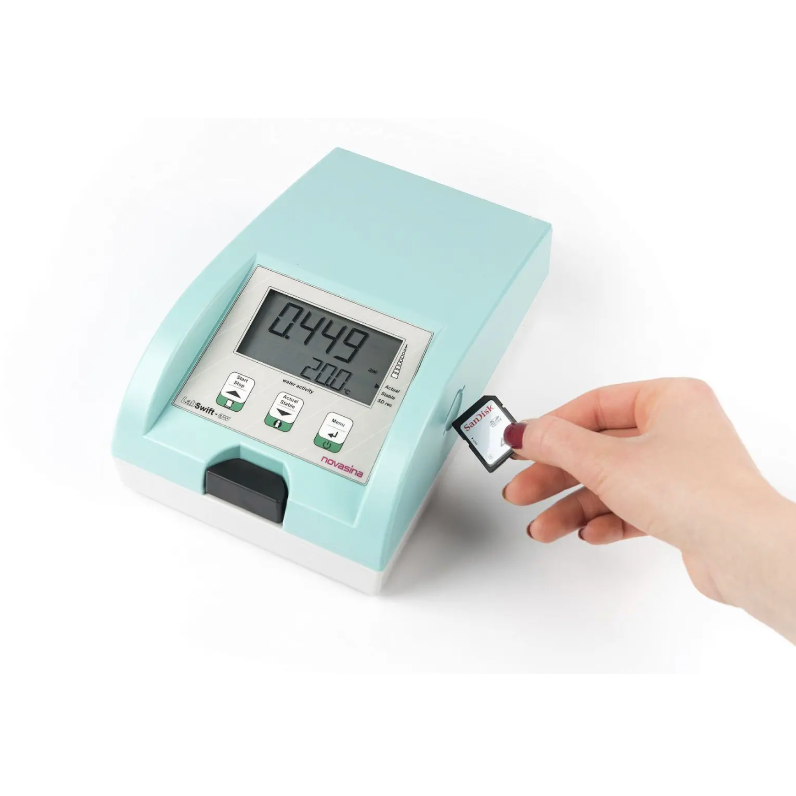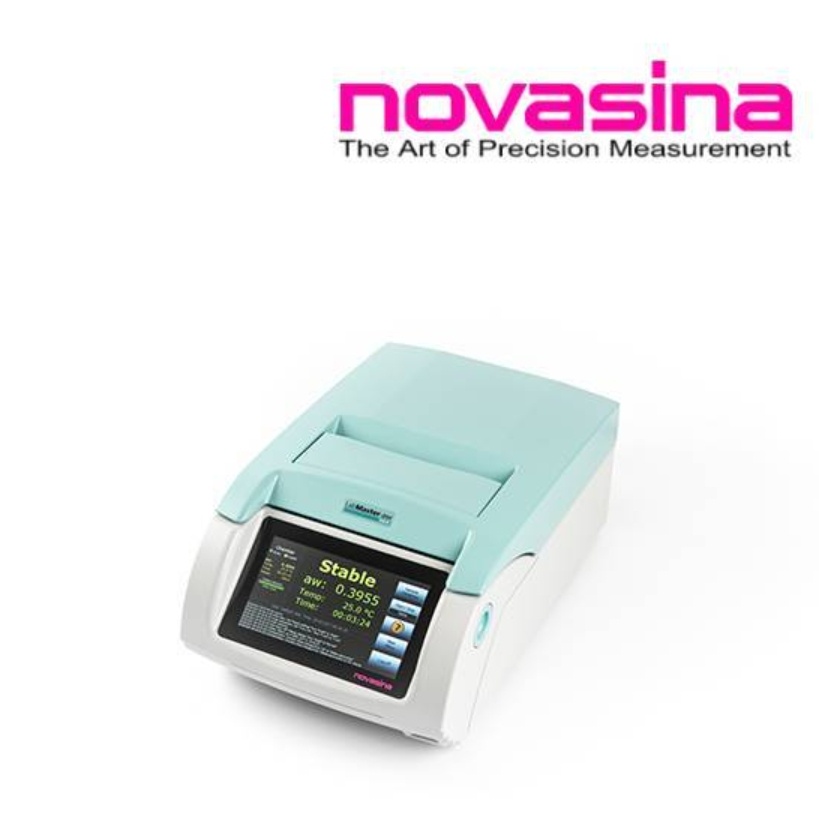为了综合水分活度及玻璃化转变理论构建状态图,获得灰枣粉的较佳贮藏条件,该文采用静态称量法(测量水分活度)和差示扫描量热法测定灰枣粉的吸附特性及玻璃化转变温度。结果表明,膨化干燥灰枣粉水分吸附的平衡干基含水率随水分活度的增加而增加,水分吸附等温线呈J 型,描述灰枣粉水分吸附特性的适宜模型为GAB 模型。
方案详情

农业工程学报Transactions of the Chinese Society of Agricultural Engineering第31卷 第21期2015年 11月Vol.31 No.21Nov. 2015 265 2015年农业工程学报 (http://www.tcsae.org)266 膨化干燥灰枣粉玻璃化转变及贮藏稳定性 毕延娣1.2,陈芹芹²,毕金峰1.2※颜廷才1,吴昕烨2,赵 悦1.2 (1.沈阳农业大学食品学院,沈阳110866; 2. 中国农业科学院农产品加工研究所农业部农产品加工重点实验室,北京100193) 摘 要:为了综合水分活度及玻璃化转变理论构建状态图,获得灰枣粉的较佳贮藏条件,该文采用静态称量法和差示扫描量热法测定灰枣粉的吸附特性及玻璃化转变温度。结果表明,膨化干燥灰枣粉水分吸附的平衡干基含水率随水分活度的增加而增加,水分吸附等温线呈J型,描述灰枣粉水分吸附特性的适宜模型为 GAB 模型(R=0.9968);灰枣粉的玻璃化转变温度随含水率升高而降低,湿基含水率由0.064增加到0.175 g/g时,玻璃化转变转度由29.90降低到-35.02℃;灰枣粉干基含水率≤0.1223g/g、贮藏温度≤-0.062℃时其稳定性较好,研究结果为灰枣粉加工、运输等过程中的贮藏条件提供理论参考。 关键词:贮藏;温度;水分;灰枣粉;吸附等温线;玻璃化转变温度;状态图 doi:10.11975/j.issn.1002-6819.2015.21.035 中图分类号: TS255.4 文献标志码:A 文章编号:1002-6819(2015)-21-0265-06 毕延娣,陈芹芹,毕金峰,颜廷才,吴昕烨,赵 悦.膨化干燥灰枣粉玻璃化转变及贮藏稳定性[J].农业工程学报, 2015, 31 (21): 265-270. doi: 10.11975/j.issn.1002-6819.2015.21.035 http://www.tcsae.org Bi Yandi, Chen Qinqin, Bi Jinfeng, Yan Tingcai, Wu Xinye, Zhao Yue. Glass transition and storage stability for explosion puffingdried jujube powder[J]. Transactions of the Chinese Society of Agricultural Engineering (Transactions of the CSAE), 2015,31(21):265-270. (in Chinese with English abstract) doi:10.11975/j.issn.1002-6819.2015.21.035 http://www.tcsae.org 引 言 枣 (Zizyphus jujube)是一种鼠李科水果,起源于中国,,已有4000多年历史。枣含有丰富的营养成分,包括维生素、蛋白质、脂肪、碳水化合物、矿物质和其他生理活性物质。此外,枣还具有多种保健功能,如保护肝脏、抗氧化、抗肿瘤、增强免疫力等。由于其优越的营养和保健功能,近年来逐渐受到大众的青睐。枣种类繁多,其中灰枣也称若羌灰枣,味道甜于其他种类,盛产于中国新疆若羌和河南新郑。灰枣含水率较高,容易腐烂,制备成灰枣粉可解决其不耐贮藏的弊端12-31。 自20世纪80年代以来,通常采用水分活度 a.,来评价食品的贮藏稳定性,食品在(或低于)其单分子层含水率时贮藏较稳定,但近年来,有学者提出其衡量食品贮藏稳定性有一定局限性,因此提出了玻璃化转变理论来弥补水分活度作为贮藏稳定性衡量标准的缺陷4。根据非晶态无定形聚合物的力学性质随温度变化的特征,将食品分为玻璃态,橡胶态和黏流态,玻璃化转变是从玻璃态到橡胶态或橡胶态到玻璃态的转变,其特征温度称 ( 收稿日期:20 1 5-08-14 修订日期:2015-09-29 ) ( 基金项目:国家自然科学基金项目(31401508);国家“ 十二 五”科技支撑计划课题“复合果蔬新产品创制与节能减排关键技术开发及示范” (2012BAD31B06)。 ) ( 作者简介:毕延娣,女,研究方向果蔬产品加工理论与技术。沈阳 沈阳农业大学食品学院,110866 。 Emai l : bi.yandi@163.com ) ( ※通信作者:毕金峰,男,博士,研究员,博士生导师,研究方向为果蔬精深加工与副产物综合利用技术。北京 中国农业科学院农产品加工研究所果蔬加工研究 室 。Email: bijinfeng2010@163.com ) 为玻璃化转变温度(T)。当体系温度低于T时,所处的状态为玻璃态,此时分子运动能量低,分子链段基本处于“冻结”状态,只有较小的运动单元(侧链、支链等)能够运动,体系黏度很高,体系相对稳定。相反,体系温度高于T,时,处于橡胶态,黏度降低,反应加快。在测定时,当体系发生玻璃化转变时,热流曲线会出现一个“台阶”,玻璃化转变不是一个点,而是一个区域范围。玻璃态食品常被认为是稳定的,T,值已成为食品品质的一个重要预测指标,周顺华等6、陈洁等对玻璃化转变温度的概念及其与食品贮藏稳定性之间的关系进行了详细的介绍。 随着对水分活度和玻璃化转变理论认识的不断深入,越来越多的学者通过构建状态图将这2种理论结合起来用以预测食品贮藏稳定性,,目前有文献对猕猴桃、苹果、南非棕榈海枣[10]等水果的状态图进行报道,然而关于中国灰枣状态图的研究,国内外至今未见公开成果发表。 本文研究膨化干燥灰枣粉的吸附等温线及玻璃化转变温度,通过构建状态图探讨膨化干燥灰枣粉水分活度、含水率、玻璃化转变温度间的关系,以期为灰枣粉较佳贮藏条件的选择提供理论依据。 材料与方法 1.1 材料与试剂 灰枣,购于新疆塔里木大漠枣业有限公司;氯化化、醋酸钾、氯化镁、碳酸钾、溴化钠、氯化钠、氯化钾、氯化钡均为分析纯,购于北京广大恒益有限公司;康卫 皿,购于北京广大恒益有限公司;35 mm一次性塑料培养皿,浙江柏美特医用塑料有限公司。 1.2仪器与设备 QDPH10-1压温压差果蔬膨化干燥机,天津勤德新材料科技有限公司; FW100 高速万能粉碎机,天津市泰斯特仪器有限公司;激光粒度仪 S3500, 美国 Microtrac 公司; DHG-9023A 电热恒温鼓风干燥箱,上海精宏实验设备有限公司; DSC-Q200 差示扫描量热仪,美国TA仪器公司;电子天平(精度0.1mg),赛多利斯科学仪器(北京)有限公司 1.3方法 1.3.1枣粉的制备 取无伤病灰枣,用流动水清洗后切片,厚度约为6mm。采用变温压差膨化方法干燥枣片,根据前期干燥试验优化得到工艺参数为:膨化温度90℃、停滞时间20 min、化化压力 0.2MPa, 抽空温度60℃,抽空时间1.5 h。将干燥后枣片放入高速万能粉碎机中制粉,每次 打粉时间10s, 打粉间隔2min, 共打粉3次。打粉后采用直接干燥法测定其干基含水率,重复3次,得到其平均干基含水率为 0.062 g/g。利用激光粒度仪测定灰枣粉的粒径,重复3次,得到其平均粒径为114.55 um。 1.3.2吸附等温线的确定 采用静态称量法测定变温压差膨化干燥灰枣粉在25℃下的水分吸附平衡含水率。康卫皿分为内室和外室,外室预先放入12 mL不同的饱和盐溶液(表1)[11],用于在康卫皿内产生不同的水分活度(0.113~0.902)。取2.00g灰枣粉分别置于已称质量的称量皿中,称质量后分别放于康卫皿内室中,将康卫皿放置在温度为25℃的电热恒温鼓风箱内,使样品与饱和溶液在康卫皿中达到吸湿平衡[12-13]。分别在2,4,6,8,10,12,24h称量,之后每24h称量一次直到质量恒定(相隔质量变化小于 0.01g),则认为康卫皿内外室水分到达平衡。平衡后的样品测定其含水率。试验平行2次,结果取平均值。 表18种饱和溶液在25℃下的水分活度 Table1Water activity of eight kinds of saturated solution at 25℃ 饱和溶液 氯化锂 醋酸钾 氯化镁 碳酸钾 溴化钠 氯化钠 氯化钾 氯化钡 Saturated solution LiCl CHCOOK MgCl2 K2CO3 NaBr NaCl KC1 BaCl, 水分活度 Water activity aw 0.113 0.220 0.328 0.432 0.576 0.753 0.843 0.902 通过吸湿率曲线反映灰枣粉的吸湿过程。吸湿率为干燥样品某时间内从一定温度和相对湿度的周围空气中吸收的水分质量与其本身质量之比率[14],计算公式如方程(1)所示。 式中:W为样品i小时在一定温度和湿度范围空气中的吸湿率,%;m 为样品放置i小时后称量皿和吸湿样品的质量, g;ms为称量皿和干燥样品的质量, g; m。为称量皿的质量, g。 1.3.3 吸附等温线模型拟合 采用 BET、GAB、GDW3个模型[15-17]拟合灰枣粉的水分吸附,数据模型如表2所示。 表2水分吸附拟合模型 Table 2Water adsorption fitting model 模型编号 模型名称 模型数学表达式 Model number Model name Model mathematical expression BET M=MoCaw/[(1-aw)(1+(C-1)aw)] 2 GAB M=MoCKaw/[(1-Kaw)(1-Kaw+CKaw)] 3 GDW M=M Kaw[1-k(1-w)aw]/(1+Kaw)(1-kaw) 注:M为平衡干基含水率,gg;aw为水分活度,M为单分子层含水率,gg; w, k, C和K为模型参数。Note: M is equilibrium dry basis moisture content, gg; aw is water activity, Mois monolayer molecular layer moisture content, gg; w, k, C and K is modelparameter. 模型拟合精度通过决定系数(R²)、卡方检验值(X)、均方根误差(RMSE)统计参数来确定。R²越高,X、RMSE越低,模型拟合度越高。 1.3.4 玻璃化转变温度T测定与模型拟合 为了获得 0.113~0.902不同水分活度的样品,称取 2.00g灰枣粉置于称量皿中,然后一起放入装有不同饱和盐溶液的密闭容器,饱和盐溶液的水分活度见表1,25℃下放置24h 使其达到相应的水分活度,测其含水率18]。采用差式扫描热量仪 (differential scanning calorimetry,DSC)对不同含水率灰枣粉的玻璃化转变温度进行测定。 采用用(熔点156.6℃, △Hm=28.44J/g)和蒸馏水(熔点0℃,AHm=333 J/g)在封闭的埚中对仪器进行温度和灵敏度的测定。称量样品5~15 mg密封于埚内,放于DSC样品池内,以空埚作为对照。以高纯氮气为载气(50mL/60s),液氮以10℃/60 s 的速度冷却样品,使样品温度从大气温度(30~34℃)降到20℃。采用DSC双扫描程序测定不同含水率灰枣粉的 Tg, DSC 扫描程序为:水分活度0.113~0.576 的样品以20℃/min 速度由20℃冷却至-70℃,保持10 min, 平衡后以 20℃/min 加热至80℃;水分活度0.753~0.903 的样品以20℃/min 速度由20℃冷却至-90℃,保持 10 min, 平衡后以20℃/min加热至60℃[19-20]。采用 DSC 软件分析热流密度曲线,得到初始点(Ti)、中点(Tem)及终点(Toe)的玻璃化转变温度。玻璃化转变温度取其初始点即 Tgi。 玻璃化转变温度采用 Gordon-Taylor 方程进行拟合1211,如方程(2)所示。 1.4 数据分析 采用 Excel 和 origin8.0软件进行绘图及模型拟合与分析,所有试验均重复3次。 2 结果与分析 2.1 吸附等温线及模型拟合 2.1.1 吸附等温线 图1为灰枣粉的吸湿曲线,,由图可知,在24h内曲线较陡,说明此阶段样品的质量增加较快,吸附的水分较多,而后曲线趋于平缓,说明随着时间的增加样品吸附的水分越来越少直到饱和达到吸附平衡,这是由于吸湿过程是一个动态过程,在吸附刚开始时,吸湿速度较快,随着时间推移,吸湿速度迅速降低直至达到吸湿平衡1221。从图1可以看出,不同水分活度下的样品水分吸附平衡时间各不相同, a,,为0.113~0.328,在第3天质量达到恒定; a,为0.432~0.576,在第4天质量达到恒定;a,,为0.753,在第9天质量达到恒定; aw为0.843, 在第11天质量达到恒定; a,为0.902,在第17天质量达到恒定, 该结论与 Harnkarnsujarit 等1231的研究结果相似。 图1 灰枣粉吸湿率曲线 Fig.1 Hygroscopicity curve of jujube powder 灰枣粉的吸附等温线如图2所示。由图可以看出,枣粉的平衡含水率随着水分活度的增加而增大,其吸附等温线呈J型,这与 Morage 等124、Zhao等125]、Syamaladevi等126.报道的草莓、芒果、覆盆子的吸附等温线特性一致,水果、糖制品、含有大量糖和其他可溶性小分子的咖啡提取物以及多聚物含量不高的食品的等温线为J型27,多糖类物质在水中较高的溶解度可能是出现这种现象的原因[28]。 图2 灰枣粉的吸附等温线 Fig.2 Moisture sorption isotherms of jujube powder 这类吸附等温线在低 a,,时持有较低的含水率, a,在0.113~0.576范围内,灰枣粉的平衡干基含水率范围为0.06~0.20 g/g;在高 a,,时持有较高的含水率, aw为0.753,0.843 和0.902时的干基含水率分别为 0.37,0.57和0.76g/g。 2.1.2 吸附等温线拟合 采用表2所示的3种数学模型拟合灰枣粉水分吸附试验数据,通过回归分析得到模型统计参数,结果见表3。 表3 水分吸附模型拟合的统计参数值 Table 3 Model parameters of water sorption isotherms 决定系数 卡方检验值 模型 Determination 均方根误差 Chi-square value Model coefficient R RMSE X GAB 0.9968 2.279E-4 0.0011 BET 0.9771 0.0015 0.0092 GDW 0.9520 0.0032 0.0128 由表3可以看出, GAB, BET, GDW 模型的决定系数R²均大于0.95,均能较好的拟合灰枣粉的吸附等温线。对比 GAB, BET, GDW模型的评价参数,选择R²最大,, RMSE最小的 GAB 模型为描述灰枣粉水分吸附特性的适宜模型,图3为 GAB 模型拟合的吸附等温线,由图可看出, GAB 模型拟合的精度较高,参数单分子层含水率M 为 0.1223 g/g。根据文献资料[29],目前在整个水分活度范围内描述物料水分吸附最好的是 GAB 模型, 本试验结论与文献资料结论一致。 注: GAB拟合曲线的公式为: M=0.42aw/[(1-0.94aw)(1+2.50aw)],决定系数R=0.9968. Note: GAB model fitting the curve expression: M-0.42aw/[(1-0.94aw)(1+2.50aw)],the determination coefficient R=0.9968. 图3 GAB 模型拟合的灰枣粉吸附等温线 Fig.3 GAB model fitting water sorption isotherm of jujubepowder 2.2 灰枣粉玻璃化转变温度T的测定与模型拟合 利用 Universal Aanlysis 软件分析升温过程中灰枣粉的 DSC曲线,如图4所示,玻璃化转变温度的初始点(Tgi)和终点(Te)分别由延曲线变做切线和基线获得。 由图4可看出,样品的 DSC 曲线仅出现玻璃化转变,未出现冰溶解峰,说明样品中仅含非冻结水, Bai 等,Sereno 等301和Rahman 等1311采用 DSC 测定了苹果片,大蒜粉的T, 也得到了相似的结论。食品的玻璃化转变温度主要取决于食品的含水率,成分和溶质的分子量,玻 璃化转变不是在一个特定温度下的急剧变化,而是发生在--个温度范围内321。表4为灰枣粉在玻璃化转变过程中的初始点(Ti)、中点(Tgm)和终点(Tge),本文采用 Rahman等311及赵金红等133的方法,采用Toi为样品的玻璃化转变温度。由表4可看出,随着含水率的增加,玻璃化转变温度逐渐降低,含水率X,,由 0.064 g/g 增加到0.175 g/g时, Tgi由29.90℃降低到-35.02℃,这是由于水分对基质无定形成分的塑化作用刊,水是常用的增塑剂,其玻璃化转变温度在-135℃~-139℃范围内,对于大多数物质,含水率越高,玻璃化转变温度越低341。 注: aw=0.58, X,=0.124 gg湿基; Tgis Tgm, Tge分别为玻璃化转变过程中的初始点,中点和终点。 Note: aw=0.58,x,,=0.124 gg wet basis; Tgis Tgm Tge was initial, middle and endpoint of glass transition process,respectively. 图4 灰枣粉样品的 DSC 曲线 Fig.4 Typical DSC thermogram for jujube powder 表4 灰枣粉品的玻璃化转变温度 Table 4Glass transition temperature for jujube powder 湿基含水率 玻璃化转变 玻璃化转 玻璃化转 水分活度 初始点 变中点 变终点 Wet basis Water Initial point of Middle point of End point of moisture activity glass transition glass transition glass transition content X/(gg) aw temperature temperature temperature Tgi/℃ Tgm/℃ Tge/℃ 0.064 0.11 29.90 37.23 44.57 0.076 0.22 20.99 27.73 34.43 0.093 0.33 1.75 7.30 12.89 0.117 0.43 -9.61 -3.62 2.37 0.124 0.58 -11.98 -6.37 -0.77 0.155 0.75 -28.56 -23.77 -18.96 0.167 0.84 -33.24 -28.51 -23.76 0.175 0.90 -35.02 -30.40 -25.78 注: Gordon-Taylor 方程拟合曲线的公式为:T1=05.25X,-920.86X,X +6.82X决定系数R=0.9912。 Note: Gordon-Taylor equation fitting the curve expression: T=_一1C05.25X,-920.86XX+6.82X the determination coefficient R²=0.9912. 图5 Gordon-Taylor 方程拟合的灰枣粉玻璃化转变温度曲线图 Fig.5 Gordon-Taylor equation fitting glass transition temperatureof jujube powder 对Tg和a,进行相关性分析,可知Tg;和 a,之间存在显著的线性关系(R’=0.9513), Ti随 a,升高而下降,得到二者之间线性关系式如方程(3), Roos等I35J研究水分对草莓玻璃化转变影响试验中也得到了 To和a之间成线性关系的结论,与本文结果一致。 采用 Gordon-Taylor 方程对灰枣粉的To数据进行非线性拟合,决定系数R²为0.9912,图5为拟合图,由图可看出该模型对灰枣粉玻璃化转变温度的拟合效果较好。 2.3 状态图 粉末制品的吸湿、黏结、结块等现象与无定形粉末处于橡胶态有关,因此玻璃化转变温度是一个十分重要的参数。玻璃化转变理论的最大应用是状态图,脱水食品和冷冻食品的稳定性和贮藏性以及加工过程中最适温度和最适含水率的确定,可以使用状态图来预测31。 图6为膨化灰枣粉室温(25℃)下的状态图,结合了吸附等温线试验数据和 GAB模型拟合曲线以及玻璃化转变温度试验数据和 Gordon-Taylor 模型拟合曲线。通过GAB 模型合合吸附等温线得到单分子层含水率为0.1223 g/g, 根据水分活度理论I16,为保证物质稳定,最高含水率为 0.1223 g/g,最高水分活度为0.3660, 该水分活度下对应的玻璃化转变温度为-0.062℃。根据玻璃化转变温度理论,体系温度低于 To时最稳定,所以≤-0.062℃时样品为玻璃态,贮藏稳定性最高。因此,根据状态图得出,当干基含水率≤0.1223 g/g、体系温度≤-0.062℃时,灰枣粉处于玻璃态,贮藏稳定性较好。 图6 膨化干燥灰枣粉的状态图 Fig.6State diagram of explosion puffing dried jujube powder 3 结 论 本试验结合吸附等温线和玻璃化转变温度曲线构建膨化干燥灰枣粉的状态图,通过试验和分析得出以下结论: 1)膨化干燥灰枣粉吸湿平衡含水率随水分活度的增加而增加,水分吸附等温线呈J型,描述膨化灰枣粉水分吸附特性的适宜模型为 GAB 模型(决定系数R’=0.9968)。 2)由于水的塑化作用,膨化干燥灰枣粉玻璃化转变温度Ti随含含率增加而降低,湿基含水率由0.064 g/g增加到到 0.175 g/g时,玻璃化转变温度 Tgi从29.90℃降低 到-35.02℃, Gordon-Taylor 方程能较好地拟合膨化干燥灰枣粉的玻璃化转变温度(决定系数R=0.9912)。 ( 3) 通过构建状态图 , 得到为当灰枣粉干基含水率≤0.1223 g/g、体系温度≤-0.062℃时贮藏稳定性较好。 ) ( [参 考 文 献] ) ( [1] Bi J F, Chen Q Q, Zh o u Y H , et al. Optimization of sho r t- and m edium-wave infrared dr y ing and qu a lity evaluation ofjujube powder[J]. Food a nd Bioprocess Technology, 2 0 14,(7):2375-2387. ) ( [21 Chen Q Q, B i J F , Zhou Y H , et al. Multi-objectiveoptimization of spray d r ying of jujube (zizyphus juj u ba miller)powder using response s urface m ethodology[J]. F ood a nd Bioprocess Technology, 2014, 7(6 ) :1807-1818. ) ( [3] 刘小丹,张淑娟,贺虎兰,等.红枣微波-热风联合干燥特性及对其品质的影响[J].农业工程学报,2012,28(24): 280一286. ) ( Liu X iaodan, Z hang S h ujuan, H e Hulan, et al. D ry ing characteristics and its effects on quality of jujube treated by combined microwave-hot-air drying[J]. Transactions of theChinese Society of Agricultural E ngineering (Transactions ofthe CSAE), 2 012,28(24):2 8 0-286. (in Chinese withEnglish a bstract) ) [4] 石启龙,赵亚, 马占强.真空干燥雪莲果粉玻璃化转变温 度与贮藏稳定性研究[J].农业机械学报,2014,45(2): ( 215一219. Shi Qilong, Zhao Y a. Ma Zhanqiang. Gl a ss Tr an sition T emperature and S t orage S t ability of Vacuum- d r ied Y a conPowder[J]. Transactions of t hei e C Chinese e Society for Agricultural Machinery, 2014, 4 5 (2): 2 1 5-219. (in Chinese with English abstract) ) ( [5] OwenR Fennema 著, 1 9 王 璋,译.食品化学(第二版 ) [M]. 北京: :中国轻工业出版社,2003. ) ( [6 周顺华,陶乐仁,刘宝林.玻璃化转变温度及其对干燥食品加工贮藏稳定性的影响[J].真 空 与低温,2002,8(1): 48一52.Zhou S hunhua, T a o Le r en, Liu Baolin. Glass transition temperature a nd i t s i mplication f or d rying a nd stability ofdried foods[J]. Vacuum & C r yogenics, 2 0 02, 8(1): 48-52.(in Chinese with English abstract) ) ( J7] 陈洁,庄俊华.玻璃化转变在冷冻与干燥食品中的应用[]. 冷饮与速冻食品工业,199 7 (3):8-10. Chen Jie, Z huang Junhua. Ap p lication of gla s s transition in freezing and drying food[J]. Cold D rinks and Quick F r ozenFood I ndustry, 1 997(3): 8 -10 . (in C h inese wi t h En g lish abstract) ) ( [8] Wang H Y , Zhang S Z , Chen G M. G la s s transition and statediagram f or f resh a nd f reeze-dried Chinese g ooseberry[J].Journal of Food Engineering, 2008 , 84(2):307-312. ) ( [9] Bai Y, Rahman M S, Perera C O, et al. S t ate diagram of appleslices: glass transition and f reezing curves[J]. F o od ResearchInternational , 200 1 , 34(2/3):89-95. ) ( [ 1 0] G uizani N, A l-Saidi G S, Rahman M S, et a l . S tate diagramof d ates: Glass t ransition, freezing curve and m aximal-freeze- concentration c ondition[J]. Journal o f F o od Engineering, 2010,99(1):92-97. ) ( 11] GB/T 23490-2009 中华人民共和国国家标准《食品水分活 度的测定》[S]. ) ( [12] K aya A , A y din O , De m irtas C. Dr y i ng kinetics of re d delicious apple[J]. Biosystems E ngineering, 2007, 96(4): 517一524. ) ( [13] F I rederic P, Lilia M A . Application of t h e Guggenheim,Anderson and De Boer model to c o rrelate water activity andmoisture c ontent d uring o s motic dehydration of apples[J]. Journal of Food Engineering, 2004, 61(3):467一470. ) ( [14]( GB/T 16913.6-1997 中华人民共和国国家标准《粉尘物性 试验方法第6部分》[S]. ) ( 1151 王锡海.基于水分活度和玻璃化转变理论的冻干双孢蘑菇贮藏稳定性的研究[D].淄博:山东理工大学,2012. Wang X i hai. S t udy on the S t orage Stability o f AgaricusBisporus Based on W ater A c tivity and G l ass T r ansition Theory[D]. Zibo, S handong University of Technology,2012.(in Chinese with English abstract) ) ( [16] F I urmaniak S , Terzyk A P, Gauden P A. Th e general mechanism of water sorption on f o odstuffs-Importance of the multitemperature fittin g o f dat a and t he hierarchy of models[J]. Journal of Food Engineering, 2007, 82(4) : 528- 535. ) ( [17] F urmaniak S, T e rzyk A P, Golembiewski R, e t al. Searchingthe most optimal m odel of water sorption on foodstuffs in the whole range ( of relative humidity[]. Food Research International, 2009,42(8 ) :1203一1214. ) ( [18] R Ioos Y H , K a rel M . Pl a sticizing effect of water on thermal b ehavior and crystallization of amorphous f o od models[J]. Journal of Food Science, 1991,56(1):38-43. ) ( [19] S Shi Q L , W a ng X H, Zhao Y, et al. Glass transition and stat e diagram f or freeze-dried A garicus b isporus[J]. Journal of Food E ngineering, 2012 ,1 1 1(4):667一674. ) ( [20] Goula A M, Karapantsios T D, Achilias D S, e t al. W atersorption i sotherms and glass transition t emperature of spraydried tomato pulp[]. Journal o f Food E n gineering, 2008,85(1): 73-83. ) ( [2 1 ] G ordon M , Ta y lor J S . Id e al copolymers an d the second-order t ransitions o f s ynthetic r u bbers. 1. non-crystalline copolymers[J]. J ournal o f A p plied Chemistry, 19 5 2, 2(9 ) :493 一 500. ) ( [221 胡路平.气溶胶材料的吸湿性及含湿量对消光效果影响的 实验研究[D].南京:南京航空航天大学, 2006. H u Luping. Effect o f E nvironmental R elative Humidity onthe E xtinction o f A erosol M a terial[D]. N a njing, Nanjing University of Aeronautics a nd Astronautics, 2 006. ( i nChinese with English abstract) ) ( [23] Harnkarnsujarit N, Charoenrein S. Effect of water activity onsugar crystallization and p-carotene s tability of freeze-dried mango powder[J]. Journal of Food Engineering, 2011, 1 05(3):592一598. ) ( [24] M N oraga G, Martinez-Navarrete N, Chiralt A. Wa t er sorption i sotherms and g l ass t r ansition i n s t rawberries: influence o f pretreatment[J]. Journal of Food E ngineering, 2 004, 62(3): 315一321. ) ( [25] Zhao J H , L i u F , W e n X, et al. S t ate diagram for freeze-driedmango: F r eezing curve, glass t r ansition l ine a nd maximal-freeze-concentration c ondition[J]. Journal of Food E ngineering,2015, 1 57(2):49-56. ) ( [26] R oopesh M S, Sa b lani S S, Tang J, et al. State diagram andwater a dsorption i sotherm o f r a spberry ( R ubus id a eus)[J].Journal of Food Engineering, 2009, 91(3): 460-467. ) ( [27] 阐健全.食品化学[M].第二版.北京:中国农业大学出版 社,2008. ) ( [28] McMinn W A M , M a gee T R A. Thermodynamic properties of m oisture s orption o f p otatoes[J].. Journal o f Food Engineering,2003,60(3):157-165. ) ( [29] McLaughlin C P, Magee TR A. Th e de t ermination ofsorption i sotherm a nd t h e i s osteric h e ats o f s o rption f o r potatoes[]. Journal of Food Engineering, 1998, 3 5(3):267- 280. ) ( [30] S ereno A M , Sa M M, Figueirrdo A M. G lass transitions an d state diagrams f or freeze-dried and osmotically dehydratedapple[R]. Thessaloniki, Greece: P roceedings of the 11thInternational Drying Symposium (IDS 98), 1998. ) ( [31] Rahman, M S, S ab l ani, S S, Al-Habsi N, e t al. S t a te diagram of f reeze dried garlic powder by di f ferential s canning calorimetry and cooling c urve m ethods[J]. J ournal of FoodScience,2005,70(2):135- 1 41. ) ( [32] R ahman, M S. St a te diagram of foods: it s p o tential u se i n food p rocessing a nd p roduct s tability[] . Trends in Food Science and Technology, 2006,17(3):129一141. ) ( [3 3 ] 赵金红.渗透脱水-冻结与玻璃化贮藏对芒果品质的影响及动力学模拟[D].北京:中国农业大学,2014. ) ( Zhao Jinhong. Effect of Osmo-Dehydro Freezing and Glassy State Storage on t he Quality Attribute s o f Froze n Mango and Dynamic Simulation[D].Beijing, China A gricultural University, 2014. (in Chinese with English abstract) ) ( [34] Roos Y H. Water ac t ivity and p h ysical state effects onamorphous food st a bility[J]. J ournal o f Food p r ocessing andPreservation, 1993, 16(6):433-447. ) ( [35] R p oos Y H . Effect o f m o isture on t h e t h ermal behavior of strawberries studied using differential scanning calorimetry[J].Journal of Food Science, 1987, 52(1): 146-149. ) Glass transition and storage stability for explosion puffing dried jujubepowder Bi Yandil2, Chen Qinqin, Bi Jinfeng12※, Yan Tingcai, Wu Xinye², Zhao Yue2 (1. College ofFood Science, Shenyang Agricultural University, Shenyang 110866, China;2. Key Laboratory ofAgro-products Processing,Ministry ofAgriculture, Institute ofFood Science and Technology, Chinese Academy ofAgricultural Sciences, Beijing 100193, China) Abstract: Since the 1980s, water activity has been commonly used to evaluate the food storage stability, and food storage willbe more stable in or below the moisture content of monolayer molecular layer. Water activity is related to the composition,temperature and physical state of the compounds, and the physical state of food compounds is also related to the stability. Butrecently, some scholars had found the limitations of using water activity to assess the food storage stability, so the glasstransition theory was proposed. Glass transition is a well-known change in the state of amorphous materials, and thecharacteristic temperature is the glass transition temperature. When the temperature is lower than the glass transitiontemperature, the system is in glass state, energy is low, viscosity is high, and the molecular chain is segmented into “frozen”state, so the system is relatively stable. On the contrary, when the system temperature is higher than the glass transitiontemperature, the system is in rubbery state, which leads to the viscosity reduction, the free volume increasing and a variety ofchanges in motion by diffusion-controlled reactions acceleration, so the system is unstable. Therefore, food in glass state isoften considered to be stable, and the glass transition temperature has become an important predictor of food quality. With thedeep understanding of water activity and glass transition theory, more and more scholars had combined these 2 theoriestogether to predict the stability of food storage. In order to investigate the suitable storage condition of explosion puffing driedjujube (Zizyphus jujube cv. Huizao) powder, moisture sorption isotherm and glass transition temperature were determined at25°℃ by the gravimetric method and differential scanning calorimetry, respectively. Three water sorption models andGordon-Taylor equation were used to fit the moisture sorption isotherms and the glass transition temperature data, respectively.The state diagram of jujube powder was developed using the fitted moisture sorption isotherm and glass transition temperaturecurve to determine the suitable storage condition. Results showed that the equilibrium moisture content of explosion puffingdried jujube powder increased with the increasing of water activity, and the equilibrium moisture content (dry basis) wasincreased from 0.06 to 0.76 g/g as water activity increased from 0.113 to 0.902. The sorption behavior displayed “J”typeisotherms, which may be due to the high sugar content of jujube powder. The best model to describe the moisture sorptionisotherm characteristics of jujube powder was GAB model (R’=0.9968). The fitting curve indicated great fitting effect. Theglass transition temperature was decreased with the increasing of moisture content, and the glass transition temperature wasdecreased from 29.90 to -35.02℃ as moisture content (wet basis) of jujube powder was increased from 0.064 to 0.175 g/g.The Gordon-Taylor equation was used to fit the glass transition temperature nonlinearly, and the correlation coefficient (R)was 0.9912, which revealed good fitness. When dry basis moisture content was at or below 0.1223 g/g, and the temperaturewas at or below -0.062℃, the storage condition was suitable for jujube powder. Key words: storage; temperature; moisture; jujube powder; moisture sorption isotherms; glass transition temperature; statediagram ?China Academic Journal Electronic Publishing House. All rights reserved. http://www.cnki.net
确定


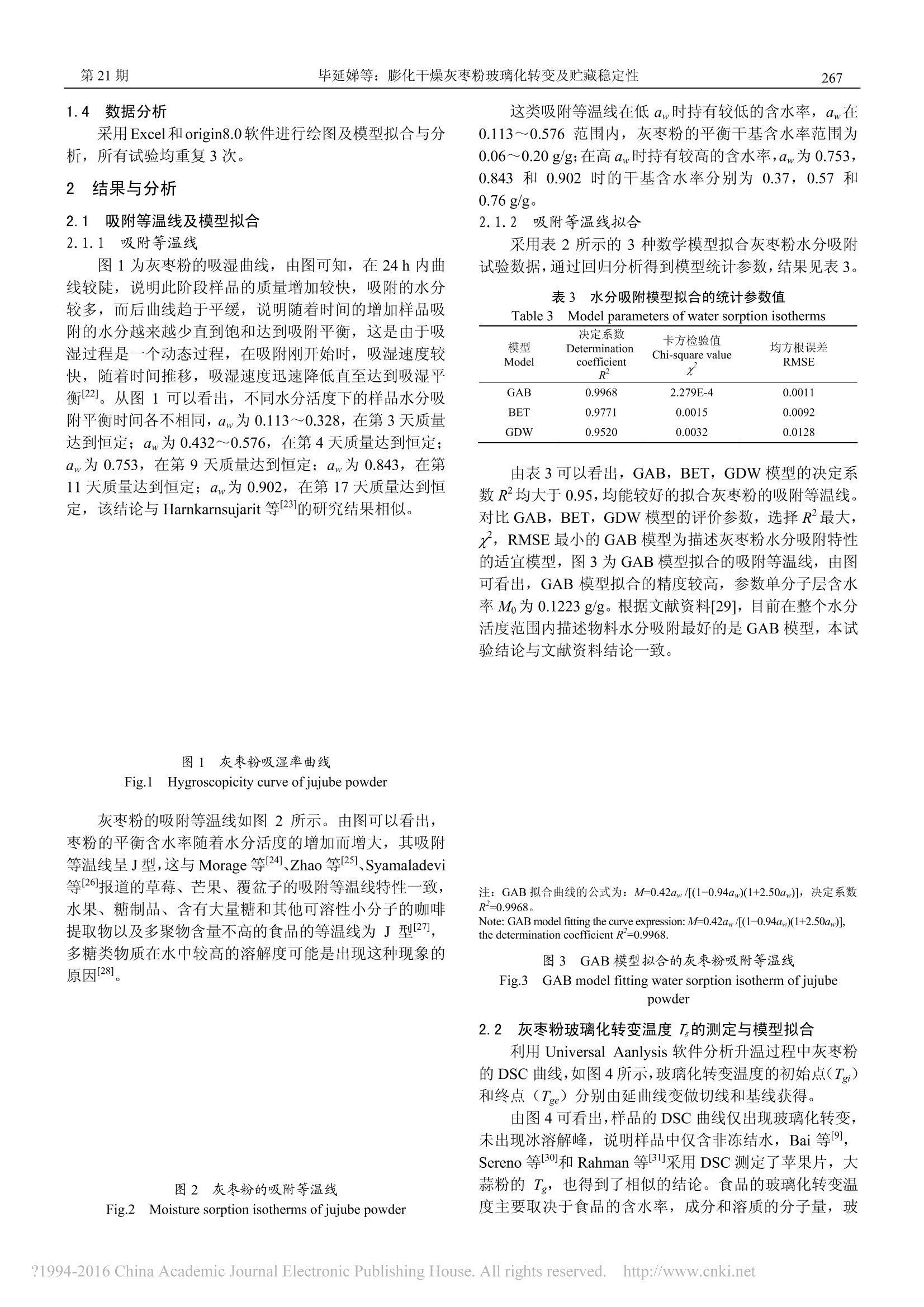

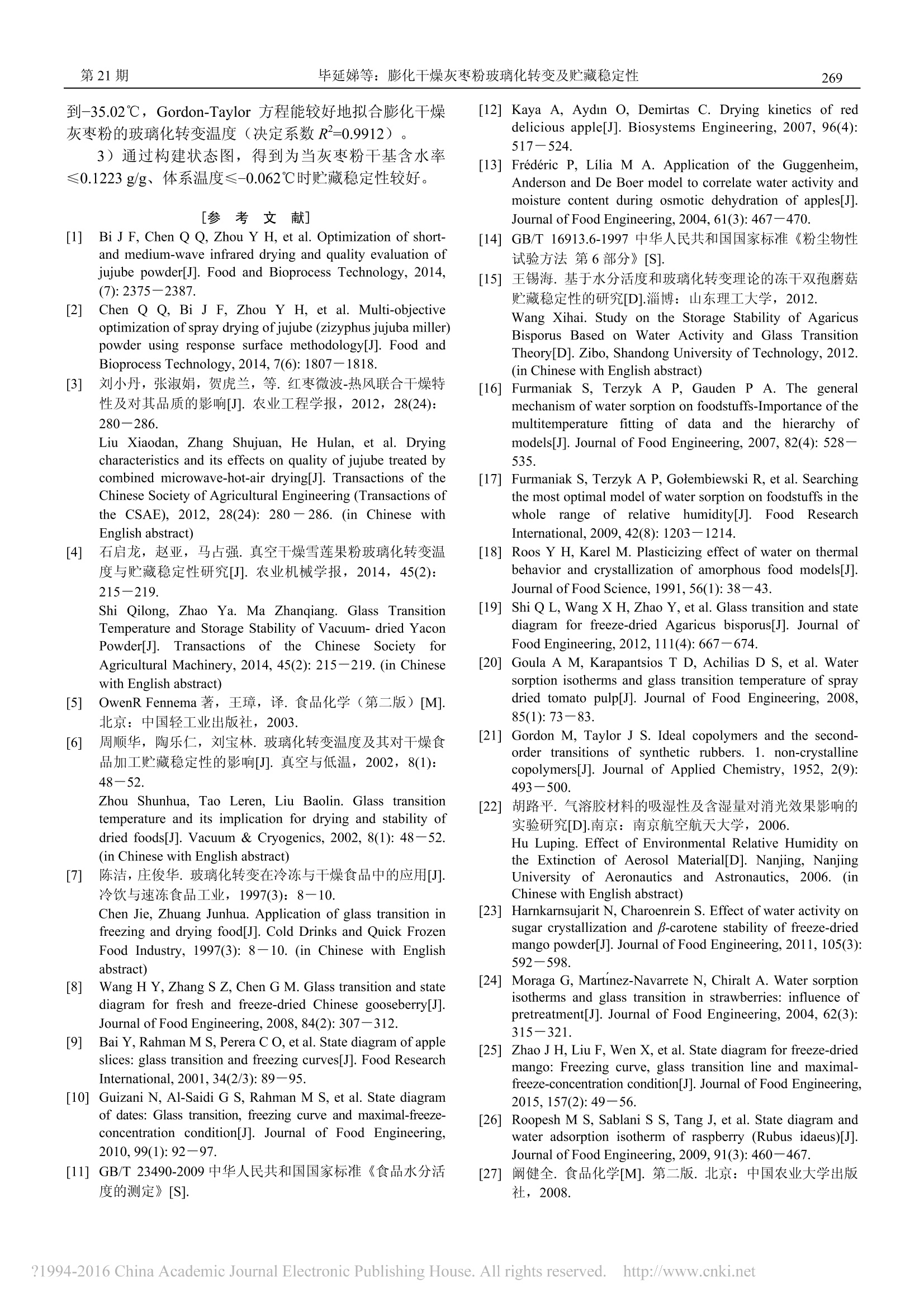
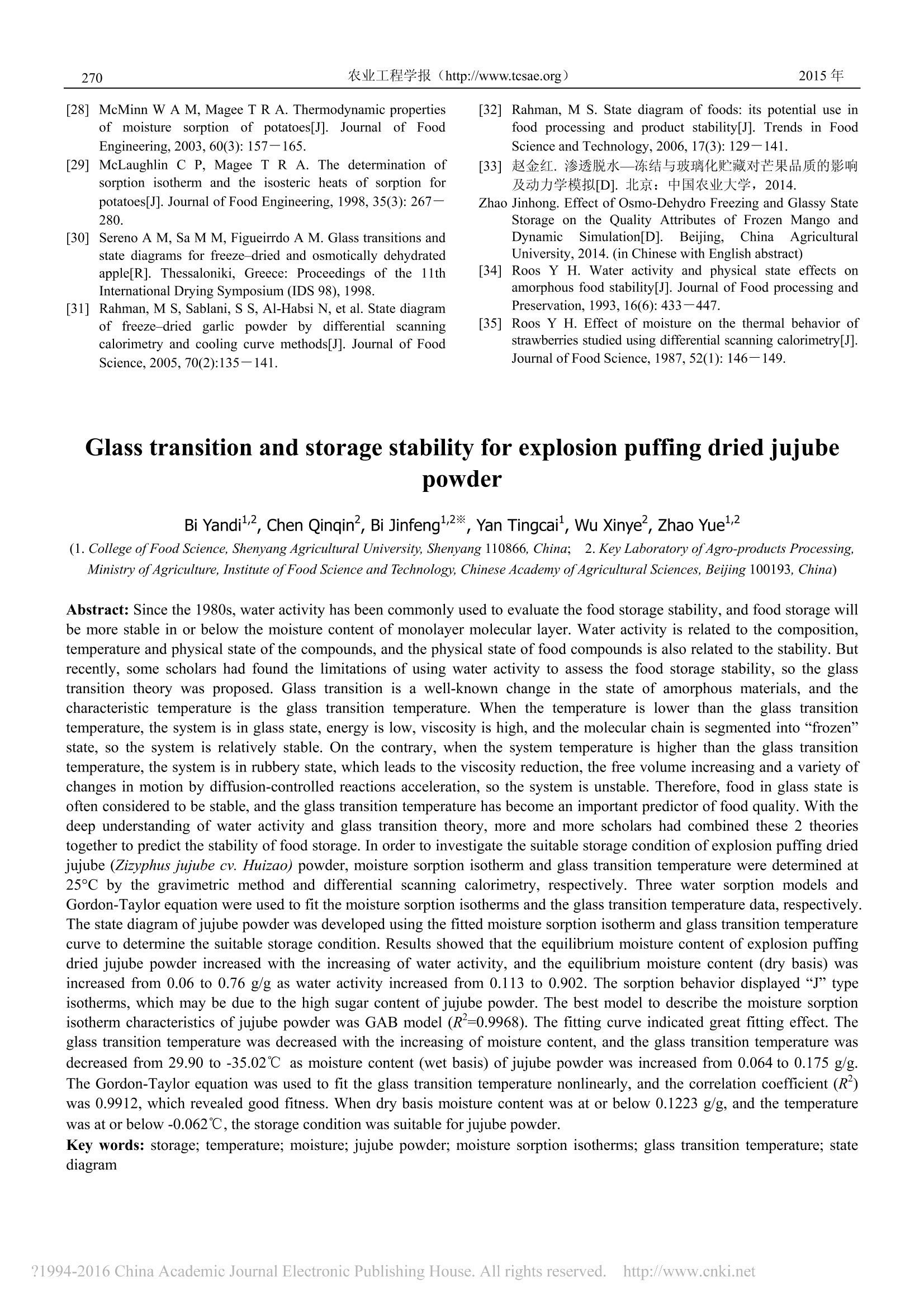
还剩4页未读,是否继续阅读?
产品配置单
METER Group, Inc.北京办事处为您提供《灰枣粉中水分活度检测方案(水活度分析仪)》,该方案主要用于其他水果制品中理化分析检测,参考标准--,《灰枣粉中水分活度检测方案(水活度分析仪)》用到的仪器有Aqualab Pre 台式温控水分活度仪、样品杯、水分活度标准溶液
推荐专场
相关方案
更多
该厂商其他方案
更多










